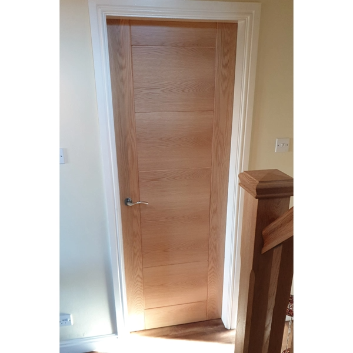Check local branch stock
-
![Deanta Ely Internal Oak Door Deanta Ely Internal Oak Door]()
![Deanta Ely Internal Oak Door Deanta Ely Internal Oak Door]()
Deanta Ely Internal Oak Door
£91.31 - £97.10 each (Ex VAT)£109.57 - £116.52 each (Inc VAT)Engineered to provide the strength and stability you want while still giving exceptional performance, t his Deanta Ely Oak Door is ideal for settings such as living rooms and bedrooms, providing complete seclusion as well as an astonishing degree of... -
![LPD Belize Fully Finished Oak Door LPD Belize Fully Finished Oak Door]()
![LPD Belize Fully Finished Oak Door LPD Belize Fully Finished Oak Door]()
LPD Belize Fully Finished Oak Door
£108.70 - £114.49 each (Ex VAT)£130.44 - £137.39 each (Inc VAT)The Pre-finished Belize internal door is great for home renovations. The popular five vertical panel design showcasing geometry has a modern twist on a traditional style and will look perfect in any contemporary home. Pre-finished, this internal door is... -
![LPD Belize Oak Door LPD Belize Oak Door]()
![LPD Belize Oak Door LPD Belize Oak Door]()
LPD Belize Oak Door
£83.33 - £346.57 each (Ex VAT)£100.00 - £415.88 each (Inc VAT)The ever so popular five vertical panel design showcasing geometry in unfinished oak has a modern twist on a traditional style and will look perfect in any contemporary home. -
![Deanta Ely Fully Finished Oak Door Deanta Ely Fully Finished Oak Door]()
![Deanta Ely Fully Finished Oak Door Deanta Ely Fully Finished Oak Door]()
Deanta Ely Fully Finished Oak Door
£120.29 - £126.09 each (Ex VAT)£144.35 - £151.31 each (Inc VAT)The Deanta Ely Fully Finished Oak Door would look great in any home. This door, with its elegant wood grain design and strong wood-grain contrast, will provide warmth and natural beauty to any area in your house. This door is handcrafted from finest... -
![Deanta Seville Fully Finished Oak Door Deanta Seville Fully Finished Oak Door]()
![Deanta Seville Fully Finished Oak Door Deanta Seville Fully Finished Oak Door]()
Deanta Seville Fully Finished Oak Door
£123.19 - £128.99 each (Ex VAT)£147.83 - £154.79 each (Inc VAT)The rich grain patterns in this door's crown-cut veneer highlight a striking combination of vertical and horizontal panels. The Seville Glazed Oak door features a slim, vertical pane of clear, toughened glass that runs down the centre of the door,... -
![Deanta Pamplona Fully Finished Oak Door Deanta Pamplona Fully Finished Oak Door]()
![Deanta Pamplona Fully Finished Oak Door Deanta Pamplona Fully Finished Oak Door]()
Deanta Pamplona Fully Finished Oak Door
This unique door showcases the gorgeous crown-cut veneer of American white oak (Quercus Alba). Contrasting orientation shows off the grain pattern to its best advantage, and the contrast is strikingly accentuated by the gentle curves of the vertical... -
![LPD DX 30s Oak Door LPD DX 30s Oak Door]()
![LPD DX 30s Oak Door LPD DX 30s Oak Door]()
LPD DX 30s Oak Door
£104.35 - £110.15 each (Ex VAT)£125.22 - £132.18 each (Inc VAT)This 30's style door design is crafted from unfinished white Oak and features three inset rectangular panels below an inset square panel. -
![LPD Mexicano Fully Finished Oak Door LPD Mexicano Fully Finished Oak Door]()
![LPD Mexicano Fully Finished Oak Door LPD Mexicano Fully Finished Oak Door]()
LPD Mexicano Fully Finished Oak Door
£126.81 - £132.61 each (Ex VAT)£152.17 - £159.13 each (Inc VAT)Ideal for use in bedrooms or lounges, the Mexicano features a classic panel design in pre-finished oak. -
![LPD Classical 2P Primed White Door LPD Classical 2P Primed White Door]()
![LPD Classical 2P Primed White Door LPD Classical 2P Primed White Door]()
LPD Classical 2P Primed White Door
£55.18 - £61.55 each (Ex VAT)£66.22 - £73.86 each (Inc VAT)Crafted from a white composite, this classical door features two raised shaped panels with an attractive curved top edge. -
![LPD Vancouver Fully Finished Oak Door LPD Vancouver Fully Finished Oak Door]()
![LPD Vancouver Fully Finished Oak Door LPD Vancouver Fully Finished Oak Door]()
LPD Vancouver Fully Finished Oak Door
£152.81 - £160.68 each (Ex VAT)£183.37 - £192.82 each (Inc VAT)The five centre panels of the Vancouver 5P door design create a ladder style effect and feature a distinctive pre-finished Oak wood grain and is a modern asset, perfect for contemporary homes. -
![LPD Carini Fully Finished Oak Door LPD Carini Fully Finished Oak Door]()
![LPD Carini Fully Finished Oak Door LPD Carini Fully Finished Oak Door]()
LPD Carini Fully Finished Oak Door
£115.94 - £132.33 each (Ex VAT)£139.13 - £158.80 each (Inc VAT)With seven centre panels and side panels in a contrasting pre-finished Oak wood grain, the Carini is a modern choice. -
![LPD Lincoln White Primed Glazed Door LPD Lincoln White Primed Glazed Door]()
LPD Lincoln White Primed Glazed Door
£133.79 - £142.69 each (Ex VAT)£160.55 - £171.23 each (Inc VAT)This attractive Lincoln design is made from a white primed solid core and features a clear glazed panel with decorative vertical bars. -
![Deanta Bury Fully Finished Oak Fire Door Deanta Bury Fully Finished Oak Fire Door]()
![Deanta Bury Fully Finished Oak Fire Door Deanta Bury Fully Finished Oak Fire Door]()
Deanta Bury Fully Finished Oak Fire Door
£194.21 - £200.00 each (Ex VAT)£233.05 - £240.00 each (Inc VAT)The neatly symmetrical Bury Solid Oak door features four bevelled-edged panels of crown-cut oak veneer. In the glazed door, the two top panels are replaced by panes of clear glass �� the bevelled edges adding a lively glint to this lovely door... -
![Deanta Ely Oak Fire Door Deanta Ely Oak Fire Door]()
![Deanta Ely Oak Fire Door Deanta Ely Oak Fire Door]()
Deanta Ely Oak Fire Door
£141.31 - £143.48 each (Ex VAT)£169.57 - £172.18 each (Inc VAT)The Ely Solid Oak door is the most popular style in the UK and complements almost any setting. The full-glazed and half-glazed options of this classic door are ideal for a modern house or flat, while the unusual horizontal symmetry of the 5L glazed door... -
![Deanta Ely White Primed Door Deanta Ely White Primed Door]()
![Deanta Ely White Primed Door Deanta Ely White Primed Door]()
Deanta Ely White Primed Door
£73.91 - £79.71 each (Ex VAT)£88.69 - £95.65 each (Inc VAT)The most popular door design in the UK, the Ely Primed White door, matches practically any space. This solid core white primed door is a popular kind of door for any home with few features and a neutral colour palette. This door is the excellent choice... -
![Deanta Seville Fully Finished Oak 1L Glazed Door Deanta Seville Fully Finished Oak 1L Glazed Door]()
![Deanta Seville Fully Finished Oak 1L Glazed Door Deanta Seville Fully Finished Oak 1L Glazed Door]()
Deanta Seville Fully Finished Oak 1L Glazed Door
£194.21 - £200.00 each (Ex VAT)£233.05 - £240.00 each (Inc VAT)The rich grain patterns in this door's crown-cut veneer highlight a striking combination of vertical and horizontal panels. The Seville Glazed Oak door features a slim, vertical pane of clear, toughened glass that runs down the centre of the door,... -
![Deanta Windsor White Primed Fire Door Deanta Windsor White Primed Fire Door]()
![Deanta Windsor White Primed Fire Door Deanta Windsor White Primed Fire Door]()
Deanta Windsor White Primed Fire Door
The Deanta Windsor White Primed Fire Door is an excellent choice for adding refinement and beauty to any area. The three exquisite bevelled-edged panels add character and charm to any scene with their gently textured surface. The biggest panel fills the... -
![LPD Belize Fully Finished Oak Fire Door FD30 LPD Belize Fully Finished Oak Fire Door FD30]()
![LPD Belize Fully Finished Oak Fire Door FD30 LPD Belize Fully Finished Oak Fire Door FD30]()
LPD Belize Fully Finished Oak Fire Door FD30
£152.18 - £157.97 each (Ex VAT)£182.62 - £189.56 each (Inc VAT)The Pre-finished Belize internal door is great for home renovations. The popular five vertical panel design showcasing geometry has a modern twist on a traditional style and will look perfect in any contemporary home. Pre-finished, this internal door is... -
![LPD Mexicano Oak Door LPD Mexicano Oak Door]()
![LPD Mexicano Oak Door LPD Mexicano Oak Door]()
LPD Mexicano Oak Door
£94.20 - £100.00 each (Ex VAT)£113.04 - £120.00 each (Inc VAT)Ideal for use in bedrooms or lounges, the Mexicano features a classic panel design in unfinished oak. -
![Deanta Ravello Fully Finished Oak Glazed Door Deanta Ravello Fully Finished Oak Glazed Door]()
![Deanta Ravello Fully Finished Oak Glazed Door Deanta Ravello Fully Finished Oak Glazed Door]()
Deanta Ravello Fully Finished Oak Glazed Door
Our Ravello doors combine the traditional beauty of American White Oak with a modern touch. The lovely curve, heavyweight feel, and wood veneer finish will offer a touch of refinement and elegance to any space in your house. This door is ready to hang... -
![LPD Belize 1L Oak Glazed Door LPD Belize 1L Oak Glazed Door]()
![LPD Belize 1L Oak Glazed Door LPD Belize 1L Oak Glazed Door]()
LPD Belize 1L Oak Glazed Door
£135.48 - £141.78 each (Ex VAT)£162.58 - £170.14 each (Inc VAT)The ever so popular five vertical panel design showcasing geometry in unfinished oak has a modern twist on a traditional style with the added benefit of a clear glazing panel with frosted lines which replaces half of the unfinsihed oak to let the light... -
![LPD Nostalgia White Primed Door LPD Nostalgia White Primed Door]()
![LPD Nostalgia White Primed Door LPD Nostalgia White Primed Door]()
LPD Nostalgia White Primed Door
Four rectangular inset shaped panels give this Nostalgia door design a classic look, complete with a versatile white finish. -
![Deanta Bury Fully Finished Oak Door Deanta Bury Fully Finished Oak Door]()
![Deanta Bury Fully Finished Oak Door Deanta Bury Fully Finished Oak Door]()
Deanta Bury Fully Finished Oak Door
£133.34 - £139.13 each (Ex VAT)£160.01 - £166.96 each (Inc VAT)The neatly symmetrical Bury Solid Oak door features four bevelled-edged panels of crown-cut oak veneer. In the glazed door, the two top panels are replaced by panes of clear glass �� the bevelled edges adding a lively glint to this lovely door... -
![Deanta Bury Fully Finished Oak Glazed Door Deanta Bury Fully Finished Oak Glazed Door]()
![Deanta Bury Fully Finished Oak Glazed Door Deanta Bury Fully Finished Oak Glazed Door]()
Deanta Bury Fully Finished Oak Glazed Door
£167.39 - £173.19 each (Ex VAT)£200.87 - £207.83 each (Inc VAT)The neatly symmetrical Bury Solid Oak door features four bevelled-edged panels of crown-cut oak veneer. In the glazed door, the two top panels are replaced by panes of clear glass �� the bevelled edges adding a lively glint to this lovely door...
Internal Doors
Wooden internal doors are traditionally used to create an occasional barrier between rooms whilst creating privacy. However, they have also taken up the role of helping to create a specific appearance to a home, whether that’s a traditional or contemporary one.
At Howarth, we currently offer a vast range of interior doors in 80+ types of doors, which are available in 10+ styles. The types of doors include:
Glazed doors, which are available as clear, obscure, and decorative to suit the needs of different areas of your home. These are a simple method of adding light to dark areas, such as hallways.
Fire doors are aimed to help protect your home in the event of a fire. All our fire doors meet the necessary building regulations. All fire doors can be chosen to match or compliment standard doors, and many of our popular door ranges are available in a fire door option.
Pre-Finished doors are ready to be hung straight away and do not need paint or stain to be applied. Pre-finished is also a good choice if you are short on time.
Unfinished doors may require sanding down to prepare them for paints and stains. These are a great option for if you have a specific colour in time, perhaps to match existing mouldings or furniture. At Howarth, we recommended this type of door for customers who are looking for a customisable option.
We also offer other types of doors, such as doors with glass, bifold doors and oak doors - which are a few of our most popular and recommended options.
We also sell a wide range of paints, stains, and preservatives to help you finish the job.
For further information and expert advice regarding wooden internal doors, please contact your friendly local Howarth branch.
Frequently Asked Questions
How to guides
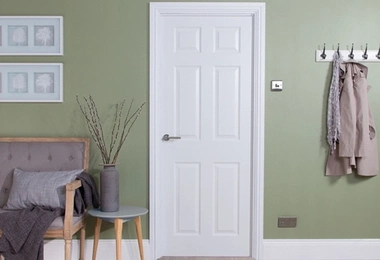
A Guide to Choosing Interior Doors
Looking for internal doors, but don't know where to start? Our guide is here to help.
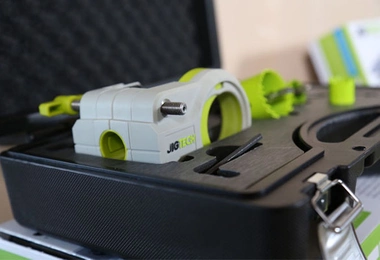
Introducing Jigtech
Discover the innovative tool that speeds up the installation of doors.
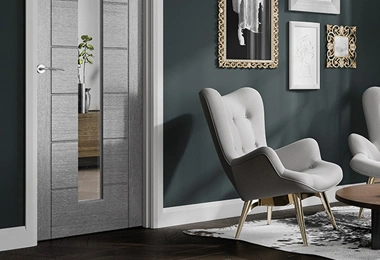
How to install an internal door
How to install an internal door guide including delivery and storage things to consider.
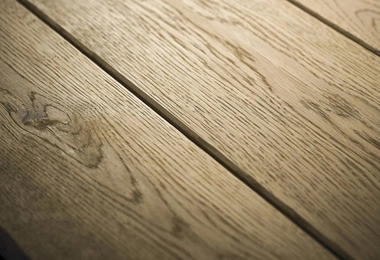
10 Things to Consider when purchasing internal oak doors
A guide explaining what things to consider when purchasing doors.
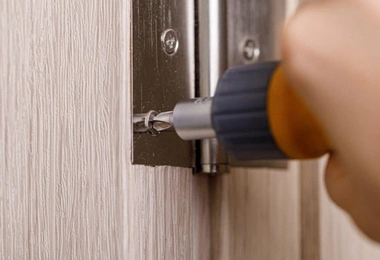
Internal Door Fitting Instructions
Do's and Don'ts when it comes to fitting your internal doors.
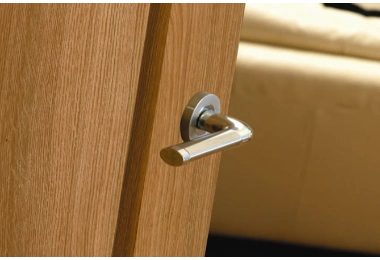
Understanding Door Construction - JB Kind Doors
An article explaining the different door constructions - read more to find out.

How to measure an internal door
A blog outlining the ins and outs of how to measure an internal door accurately and precisely.
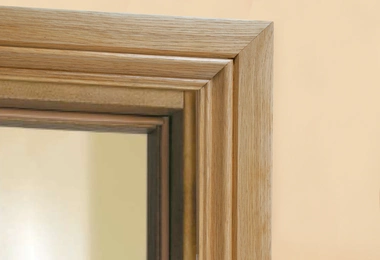
How to fit door architrave
A how-to guide detailing all the information and tools you need to be able to fit door architrave!
Customer Inspiration
